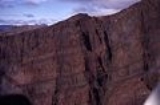
Strand Fiord Formation
Encyclopedia
The Strand Fiord Formation is a Late Cretaceous
volcanic component, located on northwestern and west-central Axel Heiberg Island
, Nunavut
, Canada
. The formation contains flood basalt
s which are found on western Axel Heiberg Island at Dragon Cliffs
300 m (984 ft) tall.
The Strand Fiord Formation contains columnar jointing units that are usually 1 m (3 ft) to 3 m (10 ft) in diameter. The formation is interpreted to represent the cratonward extension of the Alpha Ridge
, a volcanic ridge that was active during the formation of the Amerasian Basin
. The Strand Fiord Formation is also part of the High Arctic Large Igneous Province
.
Late Cretaceous
The Late Cretaceous is the younger of two epochs into which the Cretaceous period is divided in the geologic timescale. Rock strata from this epoch form the Upper Cretaceous series...
volcanic component, located on northwestern and west-central Axel Heiberg Island
Axel Heiberg Island
Axel Heiberg Island is an island in the Qikiqtaaluk Region, Nunavut, Canada. Located in the Arctic Ocean, it is the 31st largest island in the world and Canada's seventh largest island. According to Statistics Canada, it has an area of ....
, Nunavut
Nunavut
Nunavut is the largest and newest federal territory of Canada; it was separated officially from the Northwest Territories on April 1, 1999, via the Nunavut Act and the Nunavut Land Claims Agreement Act, though the actual boundaries had been established in 1993...
, Canada
Canada
Canada is a North American country consisting of ten provinces and three territories. Located in the northern part of the continent, it extends from the Atlantic Ocean in the east to the Pacific Ocean in the west, and northward into the Arctic Ocean...
. The formation contains flood basalt
Flood basalt
A flood basalt or trap basalt is the result of a giant volcanic eruption or series of eruptions that coats large stretches of land or the ocean floor with basalt lava. Flood basalts have occurred on continental scales in prehistory, creating great plateaus and mountain ranges...
s which are found on western Axel Heiberg Island at Dragon Cliffs
Dragon Cliffs
Dragon Cliffs is a basaltic monolith located on western Axel Heiberg Island, Nunavut, Canada. It is the most striking feature of Expedition Fiord and rises several hundred metres out of the fiord. Dragon Cliff is made of flood basalt lava flows that contain more than 10 flow units totalling over ...
300 m (984 ft) tall.
The Strand Fiord Formation contains columnar jointing units that are usually 1 m (3 ft) to 3 m (10 ft) in diameter. The formation is interpreted to represent the cratonward extension of the Alpha Ridge
Alpha Ridge
The Alpha Ridge is a major volcanic ridge under the Arctic Ocean between the Canada Basin and the Lomonosov Ridge. It was active during the formation of the Amerasian Basin. It was discovered in 1963. The highest elevation is about 2.7 km over the ocean floor. It is 200 to 450 km wide...
, a volcanic ridge that was active during the formation of the Amerasian Basin
Amerasian Basin
The Amerasian Basin is one of the two major basins into which the North Polar Basin of the Arctic Ocean is split by the Lomonosov Ridge . It extends from Ellesmere Island to the East Siberian Sea...
. The Strand Fiord Formation is also part of the High Arctic Large Igneous Province
High Arctic Large Igneous Province
The High Arctic Large Igneous Province is a major Late Cretaceous large igneous province located in the Arctic. It includes the Ellesmere Island Volcanics, Strand Fiord Formation, Alpha Ridge, Franz Josef Land and Svalbard.-See also:...
.
See also
- Volcanism of Canada
- Volcanism of Northern CanadaVolcanism of Northern CanadaVolcanism of Northern Canada has led to the formation of hundreds of volcanic areas and extensive lava formations across Northern Canada, indicating volcanism played a major role in shaping its surface...
- List of volcanoes in Canada
- Ellesmere Island VolcanicsEllesmere Island VolcanicsThe Ellesmere Island Volcanics are a Late Cretaceous volcanic group of volcanoes and lava flows in the Qikiqtaaluk Region of northern Ellesmere Island, Nunavut, Canada.Ellesmere Island Volcanics are part of the Arctic Cordillera...

